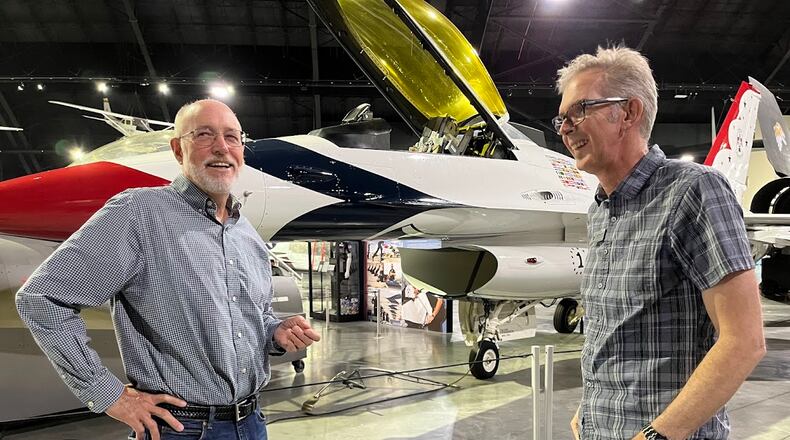Broadcasters such as Jim Baldridge, retired WHIO-TV reporter and anchor, also brought the show into viewers’ living rooms each year.
Gaffney, Greenlees and Baldridge profess a continued love for Dayton and its air show. Bringing the event to readers and viewers was hard work, but fun, the three men said in recent interviews.
Covering the show and getting to know its performers “was like having a back-stage pass to the greatest rock and roll show in the world,” said Greenlees, who now works for the National Museum of the U.S. Air Force’s public affairs team.
Greenlees first covered the air show as a journalist in 1984. Gaffney, who had been writing for the Dayton Daily News since 1979, joined him the next year after he took on the newspaper’s aviation and military affairs beat. They were both amateur pilots and flying enthusiasts who lived and breathed aviation.
Since then, the two have missed barely a handful of shows.
“Learning to fly and getting to go to one of the biggest air shows in the country — I just loved it,” said Gaffney, who after his 2006 retirement from the newspaper has written more on the Wright Brothers and area history, served on the show’s board of trustees and worked for the National Aviation Heritage Alliance.
Dayton ‘rose up and embraced it’
Baldridge recalled leading a team of reporters and videographers as they captured the show in live feeds beginning in the mid-1970s. The growing enthusiasm for the show did not take him off-guard.
“I was not surprised,” said Baldridge, who retired in 2009 and now lives in Florida. “It was wonderful entertainment. More and more people came every year, and WHIO’s coverage of it, I think, really increased the community awareness and community interest in it.”
Back then, the show was typically held on the third weekend of July. Days could be long and conditions unkind on the Dayton International Airport tarmac. Don Wayne, longtime WHIO anchorman, performed the first live broadcast from the show before handing the spot off to Baldridge the very next year.
“An awful lot of people watched TV one day, and watched (visited) the air show live the next, or vice versa,” Baldridge said. “I think the community just rose up and embraced it.”
WHIO brought a “huge crew” to the show, with photographers, vans, microwave units and more. “It looked like a network operation.”
The relationship with Wright-Patterson made the difference when it came to the show’s staying power, Gaffney and Greenlees agreed. They recalled years when the base provided “air stairs,” B-stands, generators and equipment of all kinds — not to mention helping to give the show its distinct military tone.
“You could see them coming up the highway from Wright-Patt up to Dayton International, bringing all that equipment in and then taking it out after the show,” Greenlees recalled.
The show arguably took the place of a Wright-Patterson open house that ended in the Vietnam War era, Gaffney said.
“They (the base) basically partnered with the air show and used the air show as their open house,” he said. “There was always a strong military component to the Dayton Air Show, in large part because of Wright-Patterson — and also because it’s a strong military community.”
“So many people have a relationship with aviation and the Air Force here,” said Baldridge. “I think the community was hugely supportive and still is.”
‘I’ve got your front page picture’
Gaffney and Greenlees retain an encyclopedic memory of the show, dropping names like George “J.R.” Wedekind Jr., an early show executive director; Sean Tucker, a much-loved aerobatic aviator; and Nick Engler, who built painstaking replicas of Wright Brothers aircraft, among many others.
Greenlees recalled how Tucker secured permission from the show’s air boss to perform close to a plane from which Greenlees was photographing. That soaring shot captured above the 2003 show, with Tucker’s Oracle Challenger II bi-plane above the summer crowds, became not just a page-one Dayton Daily News photo the next day, but the cover of their 2008 book.
“That’s the only time I have ever called an editor and said, ‘I’ve got your front page picture,’” Greenlees said.
While the show has thrived, not every aspect was a success. An allied trade show and exposition was held every other summer beginning in the early 1990s before ending after 2009. Gaffney said a national aviation magazine was critical of the number of domestic air show-related trade shows. Defense industry firms often wanted to show their wares in Europe, where much of their market was.
That, combined with a post-Cold War consolidation of the defense industry, did the trade show no favors, he said.
Those interviewed for this story are optimistic about the show’s future. Though Columbus has reinaugurated its own show, the Dayton event achieved an attendance record last year, with about 83,000 visitors over two days.
“It’s a quality show,” Greenlees said.
“It’s a huge part of who we are and our history,” Baldridge said. “This is where flight was invented, right here.”
Credit: Ty Greenlees�
Credit: Ty Greenlees�
50 years of the Dayton Air Show
The Dayton Daily News will have coverage of the CenterPoint Energy Dayton Air Show through next Sunday.
Inside today: Volunteers, staff help make show go
Tuesday: Air flight invention here reason for Dayton Air Show
Wednesday: History of the air show
Thursday-Sunday: Entertainment and live coverage of acts at the show
Dayton 2024 CenterPoint Energy Dayton Air Show Presented by Kroger
How to go
When: June 22-23. Gates open at 9 a.m. and close at 6 p.m. Saturday and Sunday. Air show organizers ask visitors to arrive early. Expect large crowds and heavy traffic.
Tickets: Go to daytonairshow.com. There is no call booth. Tickets include general admission parking.
Where: East side of Dayton International Airport: For general admission parking, take the Northwoods Boulevard exit from Interstate 75 and follow the signs.
About the Author





